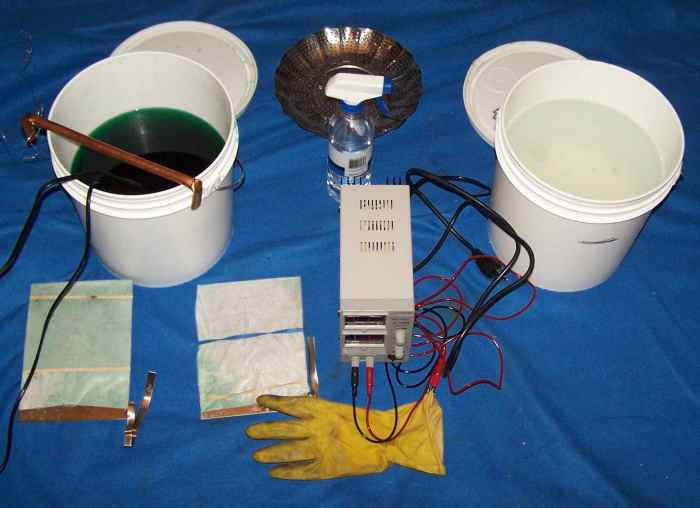DIY chrome plating allows you to transform ordinary objects into gleaming, metallic masterpieces. This process involves applying a thin layer of chromium to a surface, resulting in a durable, reflective finish. Whether you’re restoring vintage car parts, customizing motorcycle accessories, or simply adding a touch of elegance to your home décor, chrome plating offers a unique way to enhance your projects.
While professional chrome plating can be expensive, DIY methods provide a cost-effective alternative. However, it’s essential to understand that achieving professional-quality results requires patience, attention to detail, and adherence to safety precautions. This guide will walk you through the basics of DIY chrome plating, from choosing the right method to troubleshooting common issues.
What is DIY Chrome Plating?

DIY chrome plating, also known as “do-it-yourself chrome plating,” is a process that allows individuals to apply a thin layer of chrome to metal surfaces at home. This process is gaining popularity as it offers a cost-effective alternative to professional chrome plating, enabling enthusiasts and hobbyists to achieve a polished and durable finish on their projects.
The Process of DIY Chrome Plating
DIY chrome plating involves several steps, including surface preparation, electroplating, and finishing. The process typically involves:
- Cleaning and Preparation: This step involves thoroughly cleaning the metal surface to remove dirt, grease, and any existing coatings. This ensures proper adhesion of the chrome plating. Common methods include degreasing with solvents, sanding, and etching.
- Electroplating: This is the core of the process, where a thin layer of chrome is deposited onto the metal surface using an electric current. The process involves immersing the metal part in a chrome plating solution, known as an electrolyte, and applying a direct current between the part and an anode. The chrome ions in the electrolyte are attracted to the negatively charged metal surface, forming a thin chrome coating.
- Finishing: This final step involves polishing and buffing the chrome plating to achieve a desired shine and smoothness. This can be done using various tools, such as polishing wheels, buffing compounds, and polishing cloths.
Benefits of DIY Chrome Plating
DIY chrome plating offers several advantages compared to professional chrome plating, including:
- Cost-Effectiveness: DIY chrome plating can significantly reduce the cost of chrome plating, as you eliminate the need for professional services and specialized equipment.
- Convenience: It allows you to chrome plate items at your own pace and convenience, without having to rely on a professional plating shop.
- Customization: DIY chrome plating offers greater control over the plating process, enabling you to customize the finish according to your specific needs and preferences.
Drawbacks of DIY Chrome Plating
While DIY chrome plating offers benefits, it also has drawbacks, including:
- Technical Complexity: DIY chrome plating requires a good understanding of the process and its intricacies. It can be challenging for beginners and requires careful attention to detail to achieve satisfactory results.
- Safety Concerns: The chemicals used in DIY chrome plating can be hazardous and require proper handling and disposal. It’s crucial to follow safety precautions and work in a well-ventilated area.
- Limited Durability: DIY chrome plating may not achieve the same level of durability as professional chrome plating, as it may not be as thick or as evenly applied.
Tools and Materials Required for DIY Chrome Plating
The tools and materials required for DIY chrome plating vary depending on the specific method and desired outcome. However, some common essentials include:
- Chrome Plating Solution: This is the primary chemical used in the plating process. It typically contains chromic acid and sulfuric acid, which are highly corrosive and require careful handling.
- Electroplating Tank: A container that holds the plating solution and the metal part to be plated. The tank should be made of a material that is resistant to the plating solution, such as plastic or glass.
- Power Supply: A DC power supply is needed to provide the electric current for the plating process. The voltage and current requirements vary depending on the plating solution and the size of the part being plated.
- Anode: A metal rod that serves as the positive electrode in the plating process. The anode is typically made of chrome or a chrome alloy.
- Cleaning and Preparation Supplies: This includes degreasing agents, solvents, sanding paper, and etching solutions, which are used to prepare the metal surface for plating.
- Polishing and Finishing Supplies: This includes polishing wheels, buffing compounds, and polishing cloths, which are used to achieve a desired shine and smoothness on the chrome plating.
- Safety Equipment: This includes gloves, goggles, and a respirator, which are essential for protecting yourself from the hazardous chemicals used in the plating process.
With careful planning and execution, DIY chrome plating can be a rewarding experience. It allows you to personalize your projects with a timeless, lustrous finish. Remember, safety is paramount, so always prioritize proper ventilation, protective gear, and a well-equipped workspace. By following the steps Artikeld in this guide, you can embark on a journey to create your own chrome masterpieces.
DIY chrome plating is a great way to add a touch of luxury to your projects, whether it’s restoring old car parts or giving your tools a new lease on life. If you’re looking for a unique and thoughtful gift for your dad’s birthday, check out these DIY father birthday presents that will make him feel appreciated. You can even combine your DIY skills by chrome plating a tool or accessory he’d appreciate, adding a personal touch that he’ll treasure for years to come.
